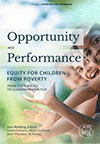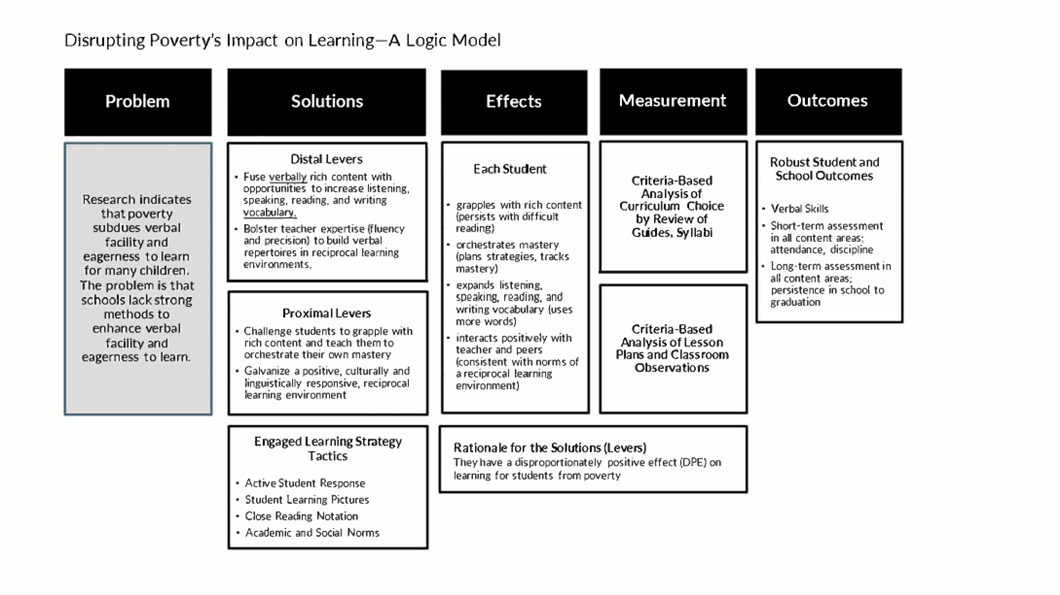
Opportunity and Performance
Equity for Children from Poverty
Edited by:
Sam Redding, Academic Development Institute
Linda Cavazos
Allison Layland, Academic Development Institute
Janet Twyman, University of Massachusetts
Bi Vuong
A volume in the series: Opportunity and Performance. Editor(s): Pam Sheley, Academic Development Institute. Sam Redding, Academic Development Institute.
Published 2021
Because everyone from policymakers to classroom teachers has a role in achieving greater equity for children from poverty, this book provides a sweeping chronicle of the historical turning points—judicial, legislative, and regulatory—on the road to greater equity, as background to the situation today. It provides succinct policy recommendations for states and districts, as well as practical curricular and instructional strategies for districts, schools, and teachers. This comprehensive approach—from the statehouse to the classroom—for providing children who come to school from impoverished environments with the education in which they thrive, not merely one that is comparable to others, truly enlists everyone in the quest for opportunity and performance. The next step toward equity may be taken by a governor, but it may also be taken by a teacher. One need not wait for the other.
Redding, S. (Ed.). (2021). Opportunity and performance: Equity for children from poverty. Information Age. Copyright: Academic Development Institute
• historical and legislative background for understanding current situation
• analysis of poverty’s impact on learning from multiple perspectives
• likely effects of COVID pandemic on learning and what to do about it
• proximal (classroom) and distal (system) levers for change
• actionable steps for teachers, schools, districts, states
• what can be done to disrupt poverty’s impact on learning, "right here, right now”
• disproportionately positive effects (DPEs) of high-impact strategies
• goalposts for measurement of progress by schools, districts, states
• glossary of terms and discussion prompts
Last year, 2021, saw a host of books and articles addressing aspects of “equity,” some mounting the bandwagon of advocacy and some arguing what the term itself actually means. But where were the clear-eyed analyses and practical solutions for educators?
After more than a year of focused attention to equity by five education scholars, their book, Opportunity & Performance, entered this stream of publications. The team is associated with the Academic Development Institute and their collaboration was supported by the National Comprehensive Center. This book is unique and distinct from others in several ways.
First, the authors agreed early on to put boundaries around a topic that could otherwise run loose with ambiguity. As they were all educators, the book would focus on equity in education. As equity could be viewed from the perspective of a variety of groups that seek it—racial and ethnic groups, children with disabilities, and English learners prominent among them—the team of authors chose to devote the book to the one historically underserved group that most pervasively suffers in terms of academic achievement and that includes the other groups. That group is children from poverty.
The five authors are not only researchers, their careers bristle with experience in schools and agencies that work with schools. From different disciplinary fields within education, they have all created and implemented strategies to improve learning and to measure that improvement. The authors were determined to logically and persuasively link their conclusions from the research on poverty, on learning, and on the nexus of the two. They wanted the book to be useful. They sought a respectful tone that would encourage common ground and constructive action to open doors of opportunity and achieve greater learning for students from impoverished environments.
The book’s authors and external advisors brought to the work a diversity of professional background and expertise on historically underserved students, children from poverty, effective instruction, systems change, and methods for evaluating progress.

Equity of opportunity: Each student—despite family income, race, ethnicity, gender, language, or disability—has the opportunity to attend schools, access courses and programs, and be taught by teachers that meet standards of quality on a par with schools attended by their peers.
Equity of performance: The schools, courses, programs, and teachers that serve students from historically underserved groups reorient their curriculum, instruction, and support services to ameliorate disadvantages these students may disproportionately bear, optimizing learning results for these students.
The Book's Authors
Linda Cavazos, Ph.D., is a researcher and technical assistance provider with more than 25 years of experience in education supporting the needs of culturally and linguistically diverse learners and directing projects in the areas of equity, diversity, inclusion, literacy, and cultural and linguistic competence, responsiveness, and sustainability.
Allison Layland, Ph.D., is the Chief Education Strategist for the Academic Development Institute (ADI) with projects in several regional centers. She has con¬sulted with 11 state education agencies on effective implementation of the Individuals with Disabilities Education Act and has more than 20 years of teaching and leadership experience in general and special education at the school, district, and state levels.
Sam Redding, Ed.D., is Chief Learning Scientist and a consultant to three regional centers. Dr. Redding also served as the Associate Director of the Center on School Turnaround (WestEd) and as Senior Learning Specialist for the Center on Innovations in Learning (Temple University), and Director of the Center on Innovation & Improvement. As a Senior Research Associate at the Laboratory for Student Success, he headed the Lab’s research and implementation of comprehensive school reform.
Janet S. Twyman, Ph.D., BCBA, LBA, Dr. Twyman is a consultant for the Academic Development Institute. Throughout her career as a preschool and elementary teacher, school principal and administrator, university professor, instructional designer, distance learning architect, and educational consultant, Dr. Twyman has been a proponent of effective learning tech¬nologies that produce individual and system change. She has presented to and worked with education systems, organizations, and institutions in over 50 states and countries, including speaking about technologies for diverse learners and settings at the United Nations.
Bi Vuong, MPA, is the Managing Director, Education Practice with Project Evident. Before joining Project Evident, Bi was the Director of Proving Ground at the Center for Education Policy Research at Harvard University. She also launched the National Center for Rural Education Research Network. Prior to Proving Ground, she served as the Deputy Chief Financial Officer for the School District of Philadelphia. Bi serves as a consultant for the Academic Development Institute with project assignments for several regional centers.
The Book’s External Advisors
Patricia Edwards, Ph.D. is professor of language and literacy at Michigan State University, a member of the Reading Hall of Fame, with research and publications on multicultural literacy, parent involvement, and related topics, especially among poor and minority children.
Sheneka Williams, Ph.D. is professor and chairperson of the Department of Educational Administration at Michigan State University with a outstanding body of research on educational opportunity for African American students.
T. V. (Joe) Layng, Ph.D. is a behavioral scientist with a distinguished career in research and practice, advancing learning through effective instruction for diverse students; Dr. Layng’s work focuses on the integration of technology with instructional design and systemic behavior interventions.
Contact: Dr. Sam Redding at sredding@adi.org
CONTENTS
About the Authors. Preface. Introduction. PART I: TRACING OUR STEPS TOWARD EQUITY CHAPTER 1: Where We Have Landed. CHAPTER 2: The Long and Winding Road. CHAPTER 3: Equity in the Every Student Succeeds Act. CHAPTER 4: Recommendations for States and Districts. References. PART II: POVERTY’S IMPACT ON LEARNING CHAPTER 5: Poverty’s Impact on Learning. References. PART III: DISRUPTING POVERTY’S IMPACT ON LEARNING CHAPTER 6: Disrupting Poverty’s Impact on Learning. CHAPTER 7: The Problem. CHAPTER 8: The Solution. References. PART IV: MEASURING PROGRESS CHAPTER 9: Measuring Progress. Appendix.
-
Paperback978-1-64802-587-7
Web price: $45.04 (Reg. 52.99)
-
Hardcover978-1-64802-588-4
Web price: $80.74 (Reg. 94.99)
- eBook978-1-64802-589-1

- EDU034000 - EDUCATION: EDUCATIONAL POLICY & REFORM: General
- EDU028000 - EDUCATION: Study Skills
- EDU048000 - EDUCATION: Inclusive Education
-
 Cultivating Rural Education
A People-Focused Approach for States
Cultivating Rural Education
A People-Focused Approach for States
-
 Handbook on Family and Community Engagement
Handbook on Family and Community Engagement
-
 Handbook on Personalized Learning for States, Districts, and Schools
Handbook on Personalized Learning for States, Districts, and Schools
-
 Handbook on Statewide Systems of Support
Handbook on Statewide Systems of Support
-
 Managing Performance Strategically in Education Agencies
A Guidebook for Strategic Performance Management (SPM)
Managing Performance Strategically in Education Agencies
A Guidebook for Strategic Performance Management (SPM)
-
 The Handbook on Innovations in Learning
The Handbook on Innovations in Learning
-
 The State Role in School Turnaround
Emerging Best Practices
The State Role in School Turnaround
Emerging Best Practices

